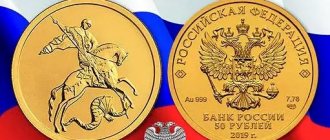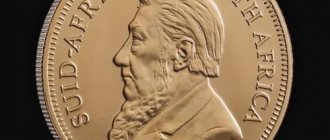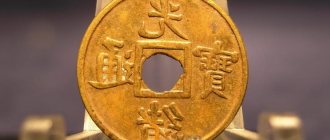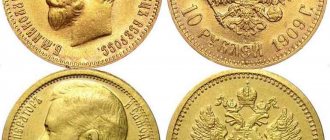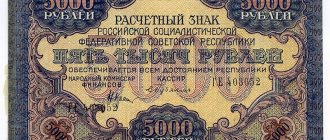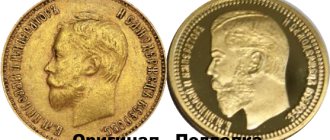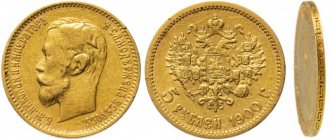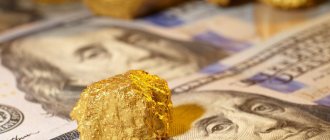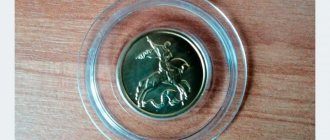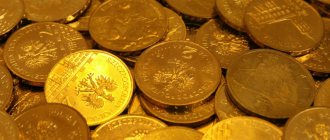A Spanish gold coin is every collector's dream. Most of the surviving copies date back to the 14th–17th centuries. When studying the development of the Spanish monetary system in general and the history of the circulation of gold coins in particular, several periods are distinguished:
- Arab;
- the colonization of the American continent and the rise of empire that was associated with it;
- Napoleonic;
- modern.
Depending on the period, the weight, quality and value of gold coins changed.
Real
The name of this monetary unit comes from the Latin word for “royal” - regalis. If in the Russian language it was spelled out with the little-used concept of “regalia,” then the Spanish and Portuguese languages turned it into “real.” It came into everyday use when the minting of coins with the same name began. Spain was a pioneer here, where the real appeared already in the second half of the fourteenth century. In Portugal, the advent of the real took place already in the fifteenth century. The real was born in noble silver, but subsequent reforms replaced the valuable metal with ordinary copper. Since both Spain and Portugal had an extensive network of colonial possessions, local monetary units borrowed a sonorous name, first as a counting measure, and then in the form of coins. The real has long been unavailable in Europe, but it remains the main currency of Brazil.
The oldest coins
The development of the monetary system in the country directly depended on the history of the peninsula. It is conditionally divided into the following periods:
- Ancient era.
- State of the Arabs.
- The era of the conquest of new lands and colonies with rich deposits of precious metals.
- Spanish Empire.
- The newest era is the republics of the 1st half of the 20th century, the dictatorship of Franco and the modern constitutional monarchy.
The first money appeared about 2400 years ago. Coins were made from silver during the period of the ancient Greek colony of Emporion and were used throughout almost the entire peninsula.
After the Arabs settled the territory of Spain, the coinage business was modernized. Maravedis were issued - silver and gold money with different contents of precious metals. During the Almoravid dynasty (from 1112 to 1220), the maravedi was made exclusively from gold, and after the reconquest of the peninsula by Christians, the denomination became a billon coin (the content of precious metals was a smaller part of the total weight). The banknote was introduced into circulation by a representative of the Burgundian dynasty, King Alfonso X. Subsequently, the maravedi was replaced by the Castilian dobla, the production of which was carried out until the end of the 15th century.
Silver escudo
The unification of European monetary systems to decimal form gave rise in Spain to a coin with the name escudo, which was equal to either ten counting reals or a hundred “centimo de escudo” - Escudo centimos. The escudo was embodied in silver. Its appearance occurred in 1864. The famous saying “The Moor has done his job, the Moor can leave” can be fully attributed to the silver escudo. In 1868, Spain joins the Latin Monetary Union. In 1869, escudos were exchanged for pesetas. The era of the silver escudo lasted only five years. The name of the coin was given by the Latin word “scutum”, which denoted a shield with a coat of arms on it. We can see the coat of arms, with few exceptions, on almost any escudo.
Varieties
Nowadays the most popular metal money in Spain are:
- 10 escudos produced in 1868: the weight of the piece is 8.4 grams. The obverse depicts a portrait of Isabella II (in profile). This Spanish gold coin has a reverse with the coat of arms of the monarchy.
- 20 pesetas issued in 1877: the mass of the specimen is 8.08 grams. Alfonso the Twelfth is depicted on the obverse, and the coat of arms is on the reverse.
- 20 pesetas of 1887: the mass of the specimen is 6.45 grams. The copy depicts Alfonso the Thirteenth.
As for the cost of such valuable specimens, in 2009, a gold coin from 1633 was sold at an auction in Barcelona, and the buyer paid 500 thousand euros for the valuable purchase. Rarities minted several centuries later were sold at higher prices.
Spanish gold escudo
But this is not all that can be said about escudo. The historical glory of the coin with this name was not silver, but gold. Barcelona, which minted this coin in 1535, can be proud of its first-born. The coin was tied to a gold mark (not a coin, but a measure of weight equal to 230 grams). One gold mark (metal purity 91.7%) was equal to sixty-eight escudos. Each coin weighed 3.38 grams. The escudo itself, in turn, was divided into three and a half hundred maravedis.
Known to us in the image of a cruel and bloody ruler in Till Eulenspiegel, Philip II makes the escudo the main coin of Spain with a gold content. Since the ratio of the value of precious metals was extremely unstable, the rate of escudo to silver coins cannot be represented as a strict constant. In one period, an escudo could be equal to four hundred maravedis; in a later period, it already included 544 small coins (with a ratio of 34 maravedis per silver real, sixteen of which consisted of one escudo).
Due to a series of protracted economic turmoil, Spain began to devalue its currency by reducing the gold content. The metal sample first becomes 900, and subsequently 875. The last golden escudo was born in 1833.
The era of Visigoth and Muslim rule
In 409 AD BC, when the Roman Empire began to decline, Emperor Constantius entered into an agreement with the Visigoths, transferring to them the Iberian Peninsula. This Germanic people had their own currency. However, the impeccable condition of the gold coins minted by the Visigothic kingdom in the 6th-7th centuries suggests that the money was not used in trade or economics, but rather served as a means of propaganda or confirmation of the legitimacy of power. Consequently, in that era, the inhabitants of the peninsula used coins issued by the Roman Empire.
The situation was completely different during the period of Muslim rule. The Arab conquest of the peninsula began in 711. Just five years later, the Muslims established control over most of Spain, which became known as Al-Andalus. In addition to dramatic political changes, the inhabitants of the peninsula also had to get used to a new monetary system, since the Arabs approved the monetary system of the Umayyad Caliphate.
The first coins were minted in the ancient Greek colony of Emporion around 400 BC. e.
The history of coins from the Al-Andalus era goes back seven centuries. During this period, they underwent several significant changes, which are explained by historical vicissitudes and changes in rulers in the region. The first coins were minted in the mid-7th century after independence from the central government of Baghdad. These were mainly silver dirhams and fels, which are today known as emirate coins. Later, when the caliphate was formed on Spanish lands, gold dinars also appeared in circulation. But the most important changes occurred in the 11th century, when the caliphate broke up into many independent emirates, or taifas, many of which began minting their own money.
The reunification of territories under the rule of the Almoravids (between the 11th and 12th centuries) and the Al-Mohads (at the end of the 12th century) returned a unified monetary system. But the days of dirhams, dob-lovs, dinars and other coins of Al-Andalus were numbered, as the troops of Christian rulers, advancing from the north, gradually reclaimed the lands from the Arabs. In 1492, Muslims were expelled from their last enclave on the peninsula, Granada.
Doubloon
The escudo coin series included denominations of one, two, four and eight units. The greatest mark on history was left by two escudos - the doubloon, produced from 1566 to 1849. The name of the coin is simply deciphered: “doblon” in Spanish and means “double”. With the entry of the doubloon into the international trade market, confusion began, since the double doubloon gained the greatest popularity, which for brevity became known as the doubloon. In the areas bordering France, the doubloon was almost the main gold coin, however, the French, who historically did not like the Spaniards, came up with their own name for the coin, “ pistol ”. In Paris, they paid attention to the coin that was in demand and created the same one, calling it “ Louis d’or ” (about it, see the article about French coins of bygone eras).
It was the time of seafarers, so golden doubloons traveled on ships along all trade routes. The Spanish colonies used doubloons as gold and foreign exchange reserves. The pirates who attacked ships also loved doubloons, so it is impossible to imagine a pirate treasure of those times without finding a single doubloon in it among the scattering of gold.
Priceless cultural monuments
Metal money has always been of interest. Of particular value are gold coins that are able to maintain their appearance even in the most unfavorable environment. An ancient treasure recovered from the ocean floor off the coast of Florida is striking in the degree of preservation of the finds. These treasures, valued at almost $5 million, are ready to go straight from the seabed to any prestigious antique auction, even without prior preparation. It is difficult to imagine how much useful information specialists, numismatists, collectors, and historians can obtain by unraveling the secrets of silent witnesses. Spanish gold has gone along with brave sailors and adventurers through difficult milestones of human history and is ready to tell the world its secrets.
Peso and piastre
Coming back to silver, it is impossible to go past the peso. If we delve into the historical roots, we invariably come to the Latin “pensum” (how can we not remember the English pence). A rough translation of "peso" is "weight". Given the popularity of thalers, Spain was concerned about issuing a similar coin, which was supposed to replace the castellano. The peso appeared at the turn of the century - in 1497 - and quickly spread throughout all the colonies, where it lived a long life, finally giving way to monetary units only at the beginning of the twentieth century. In Spain itself, the heavy peso was replaced by the peseta (“small peso”).
In neighboring territories, the peso is also known by other names. For example, piastre. During the Spanish Golden Age, the country controlled the entire south of the Apennine Peninsula, including Sicily. Here, silver tiles were initially in use - piastra d'argento, which later took on the familiar rounded appearance of a coin. Piaster weighed about twenty-five grams.
A peso is eight reals. In English-speaking countries, the term “piece of eight” arose, which can be translated as “eight”. If we started talking about set expressions, then we can recall the “highway”. It would seem, what does piastre have to do with it? But here it is necessary to remember another of its names - “Pillar Dollar”. True, what is meant here is not the striped milestones that measure distances, but the famous Pillars of Hercules, which, however, could be seen not only on piastres.
Maravedi and doba
The Maravedi is the first gold coin of Arab origin in the country's history. It was released in the 12th–13th centuries during the reign of the Almoravid dynasty. During this period, the country's monetary system was dependent on the caliphate. Only a small number of such coins fell into the hands of numismatists, but this is enough to understand what value they represented for society and the state.
Spanish gold coin 4 doubloons (8 escudos) 1798
Thus, on the obverse of the coin, known as Alphonse’s maravedi, a cross and an inscription in Arabic are depicted. This Spanish gold coin weighs four grams and contains 3.5 grams of gold. There is no doubt that the coin was of great value and was valued by its contemporaries.
At the same time, already during the reign of Alfonso X, the maravedi turned into a small change, minted from copper, giving way to the Castilian dobe. For one loot, up to 40 maravedis were given. This coin was used until 1497. It was replaced by escudos and doubloons.
Sentimo
And in conclusion, a few words about sentimo. This is a word related to the familiar cent. It derives its ancestry from the Latin “centum”, meaning “one hundred”. In Spain, it was from a hundred centimos that a peseta was collected. But when the peseta itself became a small and tiny coin, the need for centimos disappeared, and they left circulation. Nevertheless, there are also interesting moments in the life of a sentimo. Before its disappearance, this denomination managed to be part of a commemorative series dedicated to the FIFA World Cup, held in 1982 in Spain. The coin was minted ahead of time, and we see that it is not one centimo, but a whole half-peseta.
Price
Each of the listed coins is part of the country's history. After the introduction of the euro, not a single Spanish mint produces silver money, so the value of existing ones only increases every year. Coins issued more than 100 years ago are considered ancient. Their current value depends on:
- age;
- uniqueness;
- rarities;
- condition.
For example, the average price for 50 centimos is 6-8 USD, for 1 peseta – 8-12 USD, 5 pesetas in good condition cost from 15 to 25 USD. 2 reals of the 19th century cost 20-25 USD, and 5 reals – 25-30 USD. Medieval reals are valued an order of magnitude more expensive. So, 1 real 1556-1598. costs 40-50 USD, a sign of a similar denomination from 1621-1665. is estimated today at 70-80 USD.
Escudo
The desired prey of pirates of the 16th-18th centuries were chests filled to the brim with gold and silver coins. They were colorfully painted by Stevenson and Sabatini, Jacolliot and Salgari. Spanish coin names (doubloons, piastres, escudos) are often found on the pages of the novels of these wonderful writers. What attracted these coins to the “gentlemen of fortune” who sailed the seas under the “Jolly Roger”? First of all, the fullness and high purity of the precious metal.
Having created the Spanish and Portuguese colonial empires in the 16th century, their monarchs began issuing high-grade gold and silver coins. Fortunately, there was enough precious metal in abundance. After all, the richest empires of the New World - the Incas and Aztecs - were robbed. According to some estimates, during the 16th – first half of the 17th centuries, about 180 tons of gold and 16 thousand tons of silver were exported from the colonies to Spain. The Portuguese colonialists also succeeded in this “noble” task.
The Spaniards transport silver bars across the Andes on llamas. Engraving from the early 17th century
In addition, large deposits of gold and silver were found in the colonies, which were actively developed by the Spaniards and Portuguese. There was so much precious metal that in Europe at that time there was a so-called “price revolution”, that is, a fall in the value of gold and silver and a subsequent sharp and significant increase in prices for goods.
In 1535, in Barcelona, Spain, under the nominal Queen of Castile, Juana I the Mad, and the King of Spain (Castile and Aragon), Charles I (aka Holy Roman Emperor Charles V), began minting a gold coin called the escudo.
Charles I
Although the name itself had been applied to a number of gold coins earlier, it was from the 1530s that it became widespread. The Spanish and Portuguese expression "escudo d`oro" translates to "golden shield". It comes from the Latin "scutum" - shield. This name is associated with the design of the coin, on one side of which a coat of arms was depicted.
The Spanish escudo was minted from 917 gold. The total weight of the coin was 3.38 g with a pure metal weight of 3.09 g. Diameter - 24 mm. In the 17th century, the weight of pure metal in the escudo dropped to 3.03 g. As mentioned above, on the obverse of the coin there was the crowned coat of arms of the Kingdom of Spain, as well as the circular legend “IOANA ET KAROLVS”.
1 escudo of Juana and Charles, issued at the Barcelona Mint in 1535
The reverse featured a four-pointed cross in a four-arched rosette and a ribbed circle. The legend on the reverse of the escudo is “+HISPANIARVM REGES SICILIA”.
In 1535, King Charles began the so-called Tunisian War with the Ottoman Empire. The goal of the war was to consolidate the Spaniards in northern Africa. The war came down mainly to the siege of the Tunisian fortress-port of Goletta (now the city of Khalq el-Oued in Tunisia). The war required large expenses, since Charles hired 30 thousand soldiers for the siege of Goletta, and rented the largest ship of that era from the Order of Malta - the carrack "St. Anna". So, the entire first issue of escudos went precisely to cover the expenses of the Tunisian expedition.
Franz Hogenberg. Spanish siege of Goletta
By the way, the bloody siege of Goletta ended in victory for the Spaniards. The winners massacred the entire Muslim population of the fortress, and the local ruler was forced to recognize the power of Charles.
Originally, 1 escudo was equal to 350 copper maravedis.
2 maravedis. Spain. XVI century. Copper, 4.4 g
Later, 400 maravedis were required to fill the escudo. Then the following system was introduced in Spain: 1 gold escudo consisted of 16 silver reals, each equal to 34 maravedis. Accordingly, 1 escudo was equal to 544 maravedis.
At different times, the escudo had multiple units: escudillo (1\2 escudo, “escudillo” - a small shield), 2 escudo (doubloon, also known as pistol), 4 escudo and 8 escudo (quadruple).
Escudillo (1\2 escudo). Spain. 1759 Gold, 1.76 g
Doubloon (2 escudos). Spain. 1788 Gold, 6.77 g
The most famous coin among the multiple denominations of the escudo was, of course, the doubloon - the cherished dream of the robbers of the seas. We can say that this coin was the reserve currency of that era. Doubloons were extremely popular in both the Old and New Worlds.
Since the reign of the Spanish King Charles III (1759-1788), the cross on the escudo and its multiple denominations has been replaced by a bust-length portrait of the reigning monarch. The crowned coat of arms was still placed on the back of the coin. The last gold escudos were minted under Ferdinand VII (1808, 1813-1833).
The second birth of the escudo occurred in 1864. However, this time the silver escudo replaced the gold escudo. The coin was minted from .900 fine silver with a total weight of 12.98 g. The silver escudo was adapted to the International Metric System and now consisted of 100 centimos.
1 escudo. Spain. 1866
The design of the silver escudo did not differ from the gold one. On the obverse there is a portrait of the reigning monarch, on the reverse there is a coat of arms. In addition to silver escudos, gold coins were issued in the 1860s in denominations of 2, 4 and 10 escudos.
The life of the second Spanish escudo was short, but it served as the basis for the introduction of a unified and final monetary system in Spain, which was so necessary for the normalization of the economy of that time. In 1869, following the overthrow of Queen Isabella II and the creation of a Provisional Government, the escudo was replaced by the peseta, which remained Spain's currency until 2002.
As for the gold Portuguese escudo, it was a rather rare gold coin issued in the 16th – early 19th centuries. Early Portuguese coins bore the royal initials on the obverse and a coat of arms on the reverse. The initials were later replaced by a portrait of the reigning monarch.
1\2 escudo. 1726 Portugal. Joao V
The total weight of early Portuguese escudos was 4.58 g with a net gold weight of 3.43 g. In the first half of the 18th century, the net weight of the precious metal in the coin was reduced to 3.28 g. The last Portuguese gold escudos were minted in 1818-1821. Subsequently, only gold reals with denominations from 1,000 to 10,000 were minted in Portugal.
The second life of the Portuguese escudo began after the revolution of 1910, as a result of which the monarchy was overthrown. However, now the escudo was silver and consisted of 100 centavos. The coin was minted from 835 standard metal and weighed 25 g.
1 escudo. Portuguese Republic. 1915 Silver
The designer of the escudo was the Portuguese sculptor José Simões de Almeida. The obverse of the coin depicts the coat of arms of the state, and the reverse shows a woman’s head in a Phrygian cap with ears of corn – the personification of the Portuguese Republic. Since 1924, the Portuguese escudo has been minted from a base metal - aluminum bronze, since 1927 - a copper-nickel alloy, since 1969 - bronze.
1 escudo. Portuguese Republic. 1928 Copper-nickel alloy
The design and technical characteristics of the 1927 escudo remained until 1969, when a new coin was issued. After 1969, the design of the Portuguese escudo changed several times.
1 escudo. Portuguese Republic. 1971 Bronze
1 escudo. Portuguese Republic. 1992 Bronze
In 2002, the euro replaced the Portuguese escudo.
In different years of the twentieth century, escudo was the name given to the monetary units of the colonies of Spain and Portugal, as well as the countries of Africa and Asia that freed themselves from colonial rule. Currently, the escudo is the currency of Cape Verde.
Roman Novozheev
Candidate of Historical Sciences, Associate Professor
